Surface Effects and Optical Properties of Self-Assembled Nanostructured a-Si:Al
Abstract
1. Introduction
2. Materials and Methods
3. Results and Discussion
3.1. Sample Composition and Surface States
3.2. Reflectance as a Function of Al Concentration
3.3. Photoluminescence
4. Conclusions
Author Contributions
Funding
Conflicts of Interest
References
- Coxon, P.R.; Peters, M.; Cole, J.M.; Fray, D.J.; Liu, X.; Hoex, B. Black silicon: Fabrication methods, properties and solar energy applications. Energy Environ. Sci. 2014, 7, 3223–3263. [Google Scholar]
- Kanematsu, D.; Yoshiba, S.; Hirai, M.; Terakawa, A.; Tanaka, M.; Ichikawa, Y.; Miyajima, S.; Konagai, M. Observation of Quantum Size Effect from Silicon Nanowall. Nanoscale Res. Lett. 2016, 11, 277. [Google Scholar] [CrossRef] [PubMed][Green Version]
- Thiyagu, S.; Syu, H.-J.; Hsueh, C.-C.; Lin, T.-C.; Liu, C.-T. Optical trapping enhancement from high density silicon nanohole and nanowire arrays for efficient hybrid organic-inorganic solar cells. RSC Adv. 2015, 5, 13224–13233. [Google Scholar] [CrossRef]
- Kurokawa, Y.; Yano, M.; Miyajima, S.; Yamada, A. Bandgap tuning of silicon nanowire arrays for application to all-silicon tandem solar cells. Jpn. J. Appl. Phys. 2017, 56, 04CS03. [Google Scholar] [CrossRef]
- Veinot, J.G.C. Synthesis, surface functionalization, and properties of freestanding silicon nanocrystals. Chem. Commun. 2006, 12, 4160. [Google Scholar] [CrossRef] [PubMed]
- Stewart, M.P.; Buriak, J.M. Chemical and Biological Applications of Porous Silicon Technology. Adv. Mater. 2000, 12, 859–869. [Google Scholar] [CrossRef]
- Liu, D.; Ma, J.; Long, R.; Gao, C.; Xiong, Y. Silicon nanostructures for solar-driven catalytic applications. Nano Today 2017, 17, 96–116. [Google Scholar] [CrossRef]
- Ji, X.; Wang, H.; Song, B.; Chu, B.; He, Y. Silicon Nanomaterials for Biosensing and Bioimaging Analysis. Front. Chem. 2018, 6, 38. [Google Scholar] [CrossRef]
- Mariotti, D.; Mitra, S.; Švrček, V. Surface-engineered silicon nanocrystals. Nanoscale 2013, 5, 1385. [Google Scholar] [CrossRef]
- Bürkle, M.; Lozach, M.; Mcdonald, C.; Mariotti, D.; Matsubara, K.; Švrcek, V. Bandgap Engineering in OH-Functionalized Silicon Nanocrystals: Interplay between Surface Functionalization and Quantum Confinement. Adv. Funct. Mater. 2017, 27, 1701898. [Google Scholar] [CrossRef]
- Priolo, F.; Gregorkiewicz, T.; Galli, M.; Krauss, T.F. Silicon nanostructures for photonics and photovoltaics. Nat. Nanotechnol. 2014, 9, 19–32. [Google Scholar] [CrossRef] [PubMed]
- Fauchet, M.P. Photoluminescence and electroluminescence from porous silicon. J. Lumin. 1996, 70, 294–309. [Google Scholar] [CrossRef]
- Cullis, A.G.; Canham, L.T.; Calcott, P.D.J. The structural and luminescence properties of porous silicon. J. Appl. Phys. 1997, 82, 909–965. [Google Scholar] [CrossRef]
- Bustarret, E.; Sauvain, E.; Ligeon, M.; Rosenbauer, M. Temperature-dependent photoluminescence in porous amorphous silicon. Thin Solid Films 1996, 276, 134–137. [Google Scholar] [CrossRef]
- Wehrspohn, R.B.; Chazalviel, J.N.; Ozanam, F.; Solomon, I. Conditions of Elaboration of Luminescent Porous Silicon from Hydrogenated Amorphous Silicon. Phys. Rev. Lett. 1996, 77, 1885–1888. [Google Scholar] [CrossRef] [PubMed]
- Bustarret, E.; Ligeon, M.; Ortega, L. Visible light emission at room temperature from partially oxidized amorphous silicon. Solid State Commun. 1992, 83, 461–464. [Google Scholar] [CrossRef]
- Fukutani, K.; Tanji, K.; Motoi, T.; Den, T. Ultrahigh Pore Density Nanoporous Films Produced by the Phase Separation of Eutectic Al–Si for Template-Assisted Growth of Nanowire Array. Adv. Mater. 2004, 16, 1456–1460. [Google Scholar] [CrossRef]
- Saito, T.; Horie, R.; Den, T.; Bendavid, A.; Preston, E.; Martin, P. Phase separated AlSi thin films prepared by filtered cathodic arc deposition. Thin Solid Films 2009, 517, 1567–1571. [Google Scholar] [CrossRef]
- Thøgersen, A.; Jensen, I.J.T.; Stange, M.; Kjeldstad, T.; Martinez-Martinez, D.; Løvvik, O.M.; Ulyashin, A.G.; Diplas, S. Formation of nanoporous Si upon self-organized growth of Al and Si Nanostructures. Nanotechnology 2018, 29, 315602. [Google Scholar] [CrossRef]
- Rodríguez, J.A.; Vásquez-Agustín, M.A.; Morales-Sánchez, A.; Aceves-Mijares, M. Emission mechanisms of Si nanocrystals and defects in SiO2 materials. J. Nanomater. 2014, 2014, 1–17. [Google Scholar] [CrossRef]
- Shimizu-Iwayama, T.; Nakao, S.; Saitoh, K. Visible photoluminescence in Si+-implanted thermal oxide films on crystalline Si. Appl. Phys. Lett. 1994, 65, 1814–1816. [Google Scholar] [CrossRef]
- Kjeldstad, T.; Thøgersen, A.; Stange, M.; Azarov, A.; Monakhov, E.; Galeckas, A. Monitoring selective etching of self-assembled nanostructured a-Si: Al films. Nanotechnology 2019, 30, 135601. [Google Scholar] [CrossRef]
- Available online: http://www.casaxps.com/ (accessed on 4 February 2019).
- Thøgersen, A.; Selj, J.H.; Marstein, E.S. Oxidation Effects on Graded Porous Silicon Anti-Reflection Coatings. J. Electrochem. Soc. 2012, 159, D276–D281. [Google Scholar] [CrossRef]
- Iwata, S.; Ishizaka, A. Electron spectroscopic analysis of the SiO2/Si system and correlation with metal–oxide–semiconductor device characteristics. J. Appl. Phys. 1996, 79, 6653–6713. [Google Scholar] [CrossRef]
- Iacona, F.; Lombardo, S.; Campisano, S.U. Characterization by x-ray photoelectron spectroscopy of the chemical structure of semi-insulating polycrystalline silicon thin films Characterization by x-ray photoelectron spectroscopy of the chemical structure of semi-insulating polycrystalline silicon. J. Vac. Sci. Technol. B Microelectron. Nanom. Struct. Process. Meas. Phenom. 1996, 14, 2693. [Google Scholar] [CrossRef]
- Himpsel, F.J.; Mcfeely, F.R.; Taleb-Ibrahimi, A.; Yarmoff, J.A.; Hollinger, G. Microscopic Structure of the SiO2/Si Interface. Phys. Chem. SiO2 Si-SiO2 Interface 1988, 38, 219–225. [Google Scholar]
- MacLeod, H.A. Thin-Film Optical Filters, 3rd ed.; CRC Press: Boca Raton, FL, USA, 2001. [Google Scholar]
- Stenzel, O. Optical Coatings: Material Aspects in Theory and Practice; Springer: Berlin/Heidelberg, Germany, 2014. [Google Scholar]
- Bruggeman, D.A.G. Berechnung verschiedener physikalischer Konstanten von heterogenen Substanzen. I. Dielektrizitätskonstanten und Leitfähigkeiten der Mischkörper aus isotropen Substanzen. Ann. Phys. 1935, 416, 636–664. [Google Scholar] [CrossRef]
- Thøgersen, A.; Stange, M.; Jensen, I.J.T.; Røyset, A.; Ulyashin, A.; Diplas, S. Structure and optical properties of aSiAl and aSiAlHx magnetron sputtered thin films. APL Mater. 2016, 4, 36103. [Google Scholar] [CrossRef]
- Philipp, H. Optical properties of non-crystalline Si, SiO, SiOx and SiO2. J. Phys. Chem. Solids 1971, 32, 1935–1945. [Google Scholar] [CrossRef]
- Palik, E.D. Handbook of Optical Constants of Solids; Academic Press: Orlando, FL, USA, 1985. [Google Scholar]
- Malitson, I.H. Interspecimen Comparison of the Refractive Index of Fused Silica. J. Opt. Soc. Am. 1965, 55, 1205. [Google Scholar] [CrossRef]
- Knight, M.W.; King, N.S.; Liu, L.; Everitt, H.O.; Nordlander, P.; Halas, N.J. Aluminum for Plasmonics. ASC Nano 2014, 8, 834–840. [Google Scholar] [CrossRef]
- Van der Vliet, T.; Di Vece, M. Shifting the aluminum nanoparticle plasmon resonance to the visible with SiN and a-Si thin films. Thin Solid Films 2016, 603, 404–407. [Google Scholar] [CrossRef]
- Dusastre, V.; Atwater, H.A.; Polman, A. Plasmonics for improved photovoltaic devices. Mater. Sustain. Energy 2010, 9, 1–11. [Google Scholar]
- Wehrspohn, R.; Chazalviel, J.-N.; Ozanam, F.; Solomon, I. Spatial versus quantum confinement in porous amorphous silicon nanostructures. Eur. Phys. J. B 1999, 8, 179–193. [Google Scholar] [CrossRef]
- Kanemitsu, Y. Efficient light emission from crystalline and amorphous silicon nanostructures. J. Lumin. 2002, 100, 209–217. [Google Scholar] [CrossRef]
- Estes, M.J.; Möddel, G. A model of size-dependent photoluminescence in amorphous silicon nanostructures: Comparison with observations of porous silicon. Appl. Phys. Lett. 1996, 68, 1814–1816. [Google Scholar] [CrossRef]
- Estes, M.J.; Möddel, G. Luminescence from amorphous silicon nanostructures. Phys. Rev. B 1996, 54, 14633–14642. [Google Scholar] [CrossRef]
- Varshni, Y. Temperature dependence of the energy gap in semiconductors. Physica 1967, 34, 149–154. [Google Scholar] [CrossRef]
- Street, R.A. Semiconductors and Semimetals; Academic Press: Orlando, FL, USA, 1984; Volume 21B. [Google Scholar]
- Street, R.A.; Knights, J.C.; Biegelsen, D.K. Luminescence studies of plasma-deposited hydrogenated silicon. Phys. Rev. B 1978, 18, 1880–1891. [Google Scholar] [CrossRef]
- Skuja, L.N.; Silin, A.R. Optical properties and energetic structure of non-bridging oxygen centers in vitreous SiO2. Phys. Status Solidi (a) 1979, 56, K11–K13. [Google Scholar] [CrossRef]
- Kenyon, A.; Trwoga, P.F.; Pitt, C.W.; Rehm, G. The origin of photoluminescence from thin films of silicon-rich silica. J. Appl. Phys. 1996, 79, 9291–9300. [Google Scholar] [CrossRef]
- Munekuni, S.; Yamanaka, T.; Shimogaichi, Y.; Tohmon, R.; Ohki, Y.; Nagasawa, K.; Hama, Y. Various types of nonbridging oxygen hole center in high-purity silica glass. J. Appl. Phys. 1990, 68, 1212–1217. [Google Scholar] [CrossRef]
- Prokes, S.M.; Glembocki, O.J. Role of interfacial oxide-related defects in the red-light emission in porous silicon. Phys. Rev. B 1994, 49, 2238–2241. [Google Scholar] [CrossRef]
- Wolkin, M.V.; Jorne, J.; Fauchet, P.M.; Allan, G.; Delerue, C. Electronic States and Luminescence in Porous Silicon Quantum Dots: The Role of Oxygen. Phys. Rev. Lett. 1999, 82, 197–200. [Google Scholar] [CrossRef]
- Nagasawa, K.; Hoshi, Y.; Ohki, Y.; Yahagi, K. Radiation Effects on Pure Silica Core Optical Fibers by γ-Rays: Relation between 2 eV Band and Non-Bridging Oxygen Hole Centers. Jpn. J. Appl. Phys. 1986, 25, 464–468. [Google Scholar] [CrossRef]
- Arai, M.; Hannon, C.; Taylor, A.D.; Otomo, T.; Wright, A.C.; Sinclair, R.N.; Prince, D.L. Neutron-scattering law measurements for vitreous silica. Trans. Am. Crystallogr. Assoc. 1993, 27, 113–131. [Google Scholar]
- Anjiki, A.; Uchino, T. Visible Photoluminescence from Photoinduced Molecular Species in Nanometer-Sized Oxides: Crystalline Al2O3 and Amorphous SiO2 Nanoparticles. J. Phys. Chem. C 2012, 116, 15747–15755. [Google Scholar] [CrossRef]
- Spallino, L.; Vaccaro, L.; Sciortino, L.; Agnello, S.; Buscarino, G.; Cannas, M.; Gelardi, F.M. Visible-ultraviolet vibronic emission of silica nanoparticles. Phys. Chem. Chem. Phys. 2014, 16, 22028–22034. [Google Scholar] [CrossRef]
- Nishimura, A.; Sagawa, N.; Uchino, T. Structural Origin of Visible Luminescence from Silica Based Organic−Inorganic Hybrid Materials. J. Phys. Chem. C 2009, 113, 4260–4262. [Google Scholar] [CrossRef]
- Fritsch, E.; Mihut, L.; Ostrooumov, M.; Baibarac, M.; Baltog, I.; Lefrant, S.; Wery, J. Luminescence of oxidized porous silicon: Surface-induced emissions from disordered silica micro-to nanotextures. J. Appl. Phys. 2001, 90, 4777–4782. [Google Scholar] [CrossRef]
- Uchino, T.; Kurumoto, N.; Sagawa, N. Structure and formation mechanism of blue-light-emitting centers in silicon and silica-based nanostructured materials. Phys. Rev. B 2006, 73, 233203. [Google Scholar] [CrossRef]
- Irrera, A.; Artoni, P.; Iacona, F.; Pecora, E.F.; Franzò, G.; Galli, M.; Fazio, B.; Boninelli, S.M.C.; Priolo, F. Quantum confinement and electroluminescence in ultrathin silicon nanowires fabricated by a maskless etching technique. Nanotechnology 2012, 23, 075204. [Google Scholar] [CrossRef]
- Kumar, C.S.S.R. UV-VIS and Photoluminescence Spectroscopy for Nanomaterials Characterization; Springer: Berlin/Heidelberg, Germany, 2013. [Google Scholar]
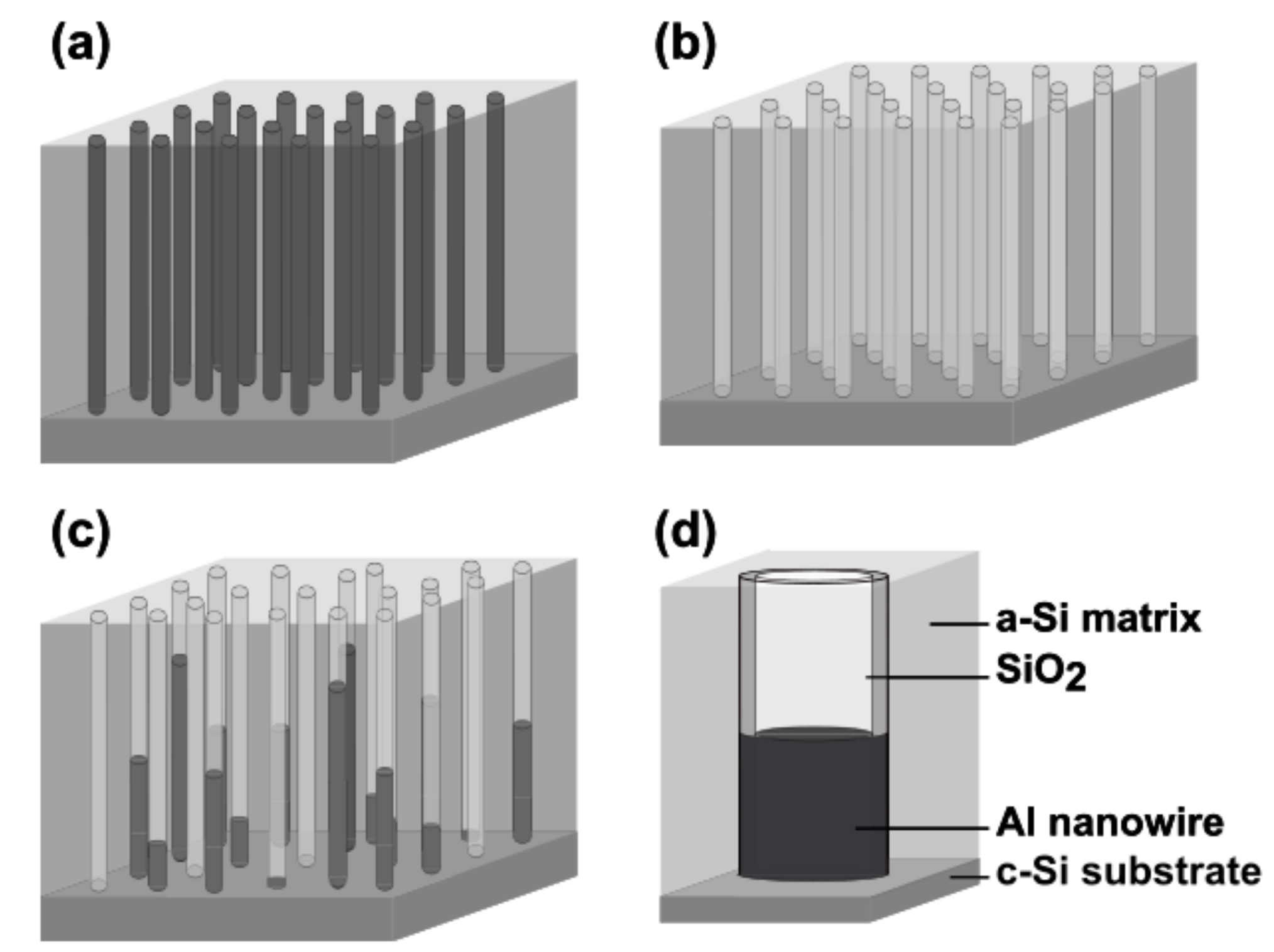
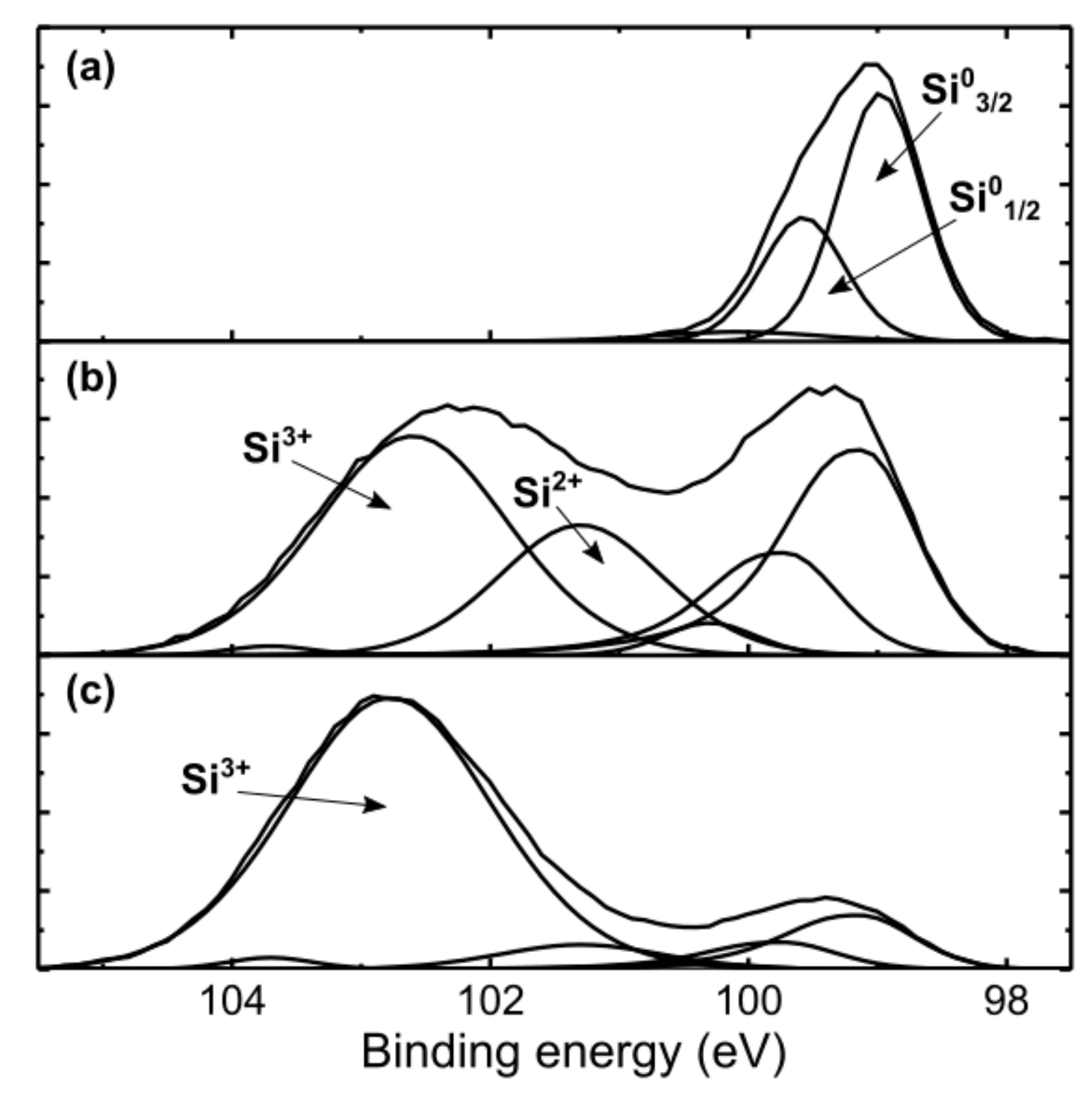
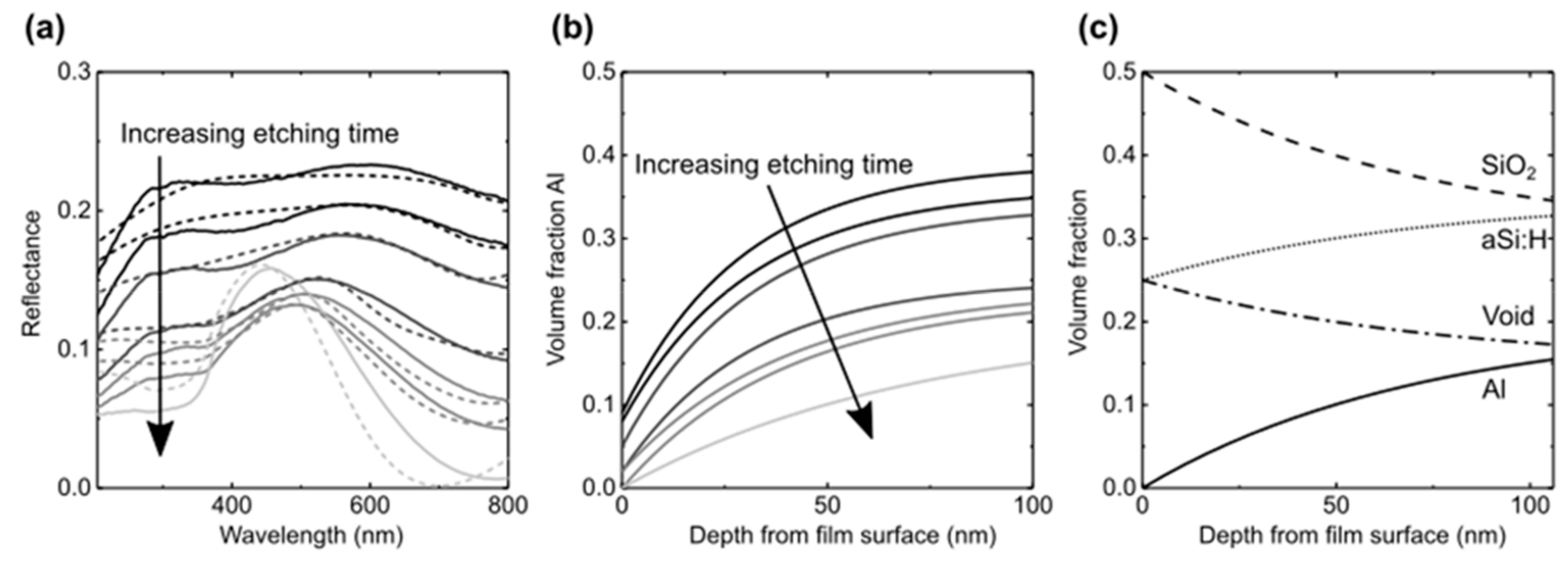
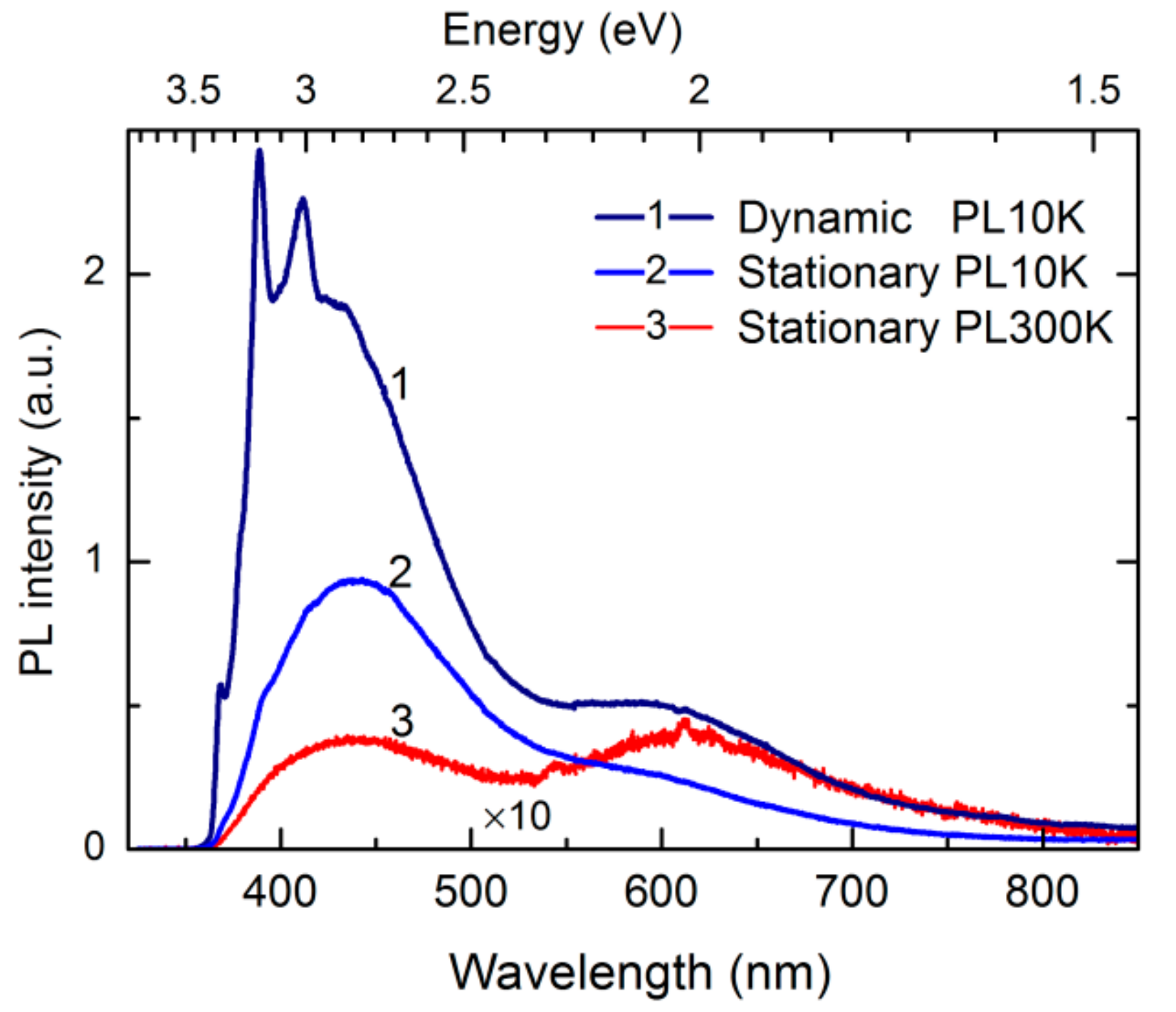
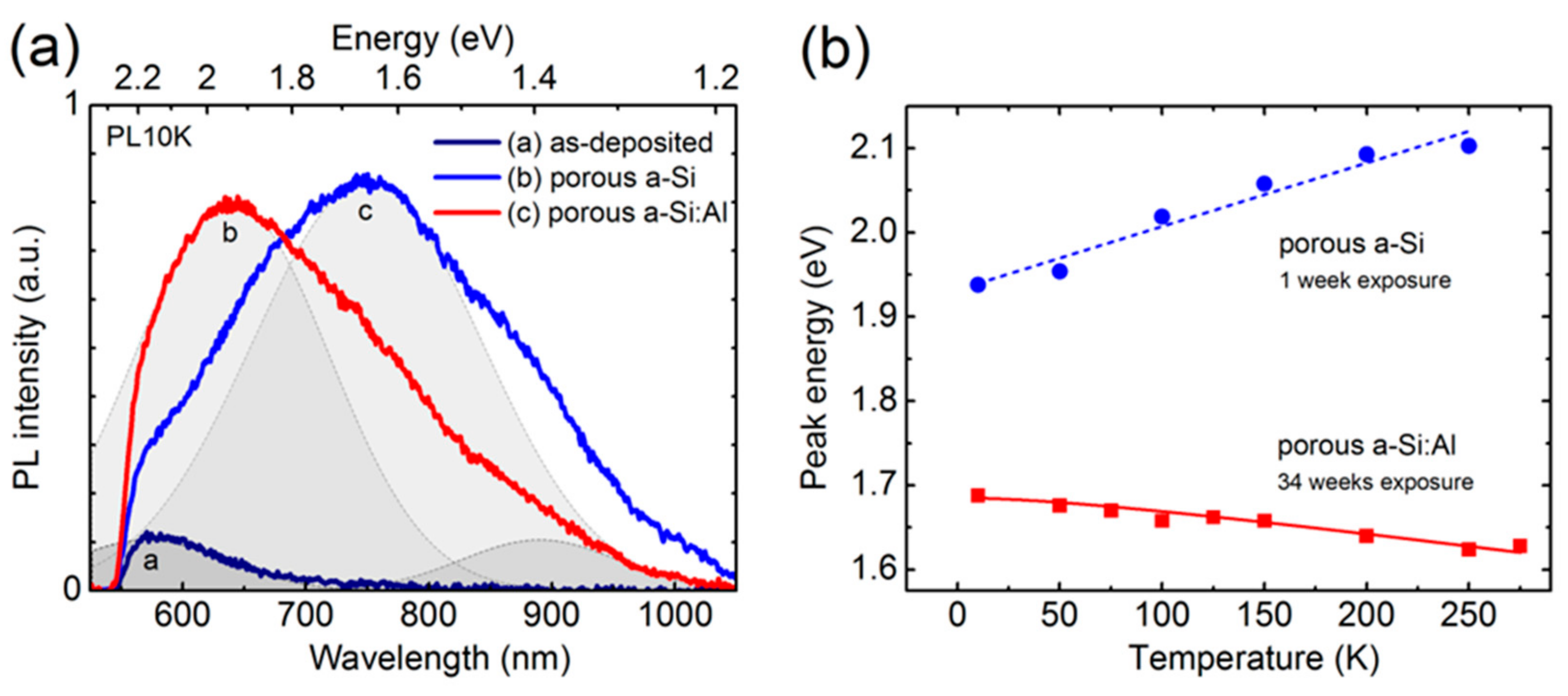
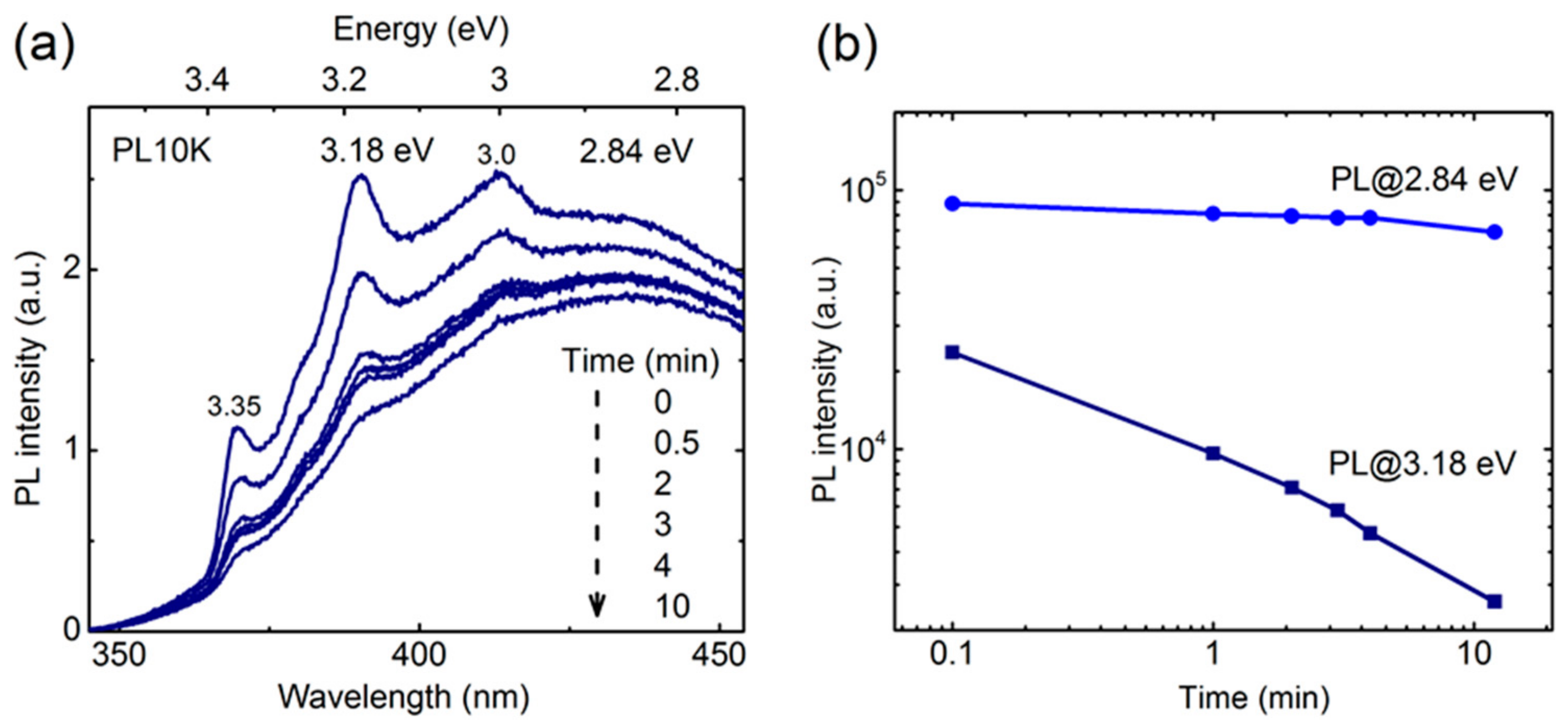
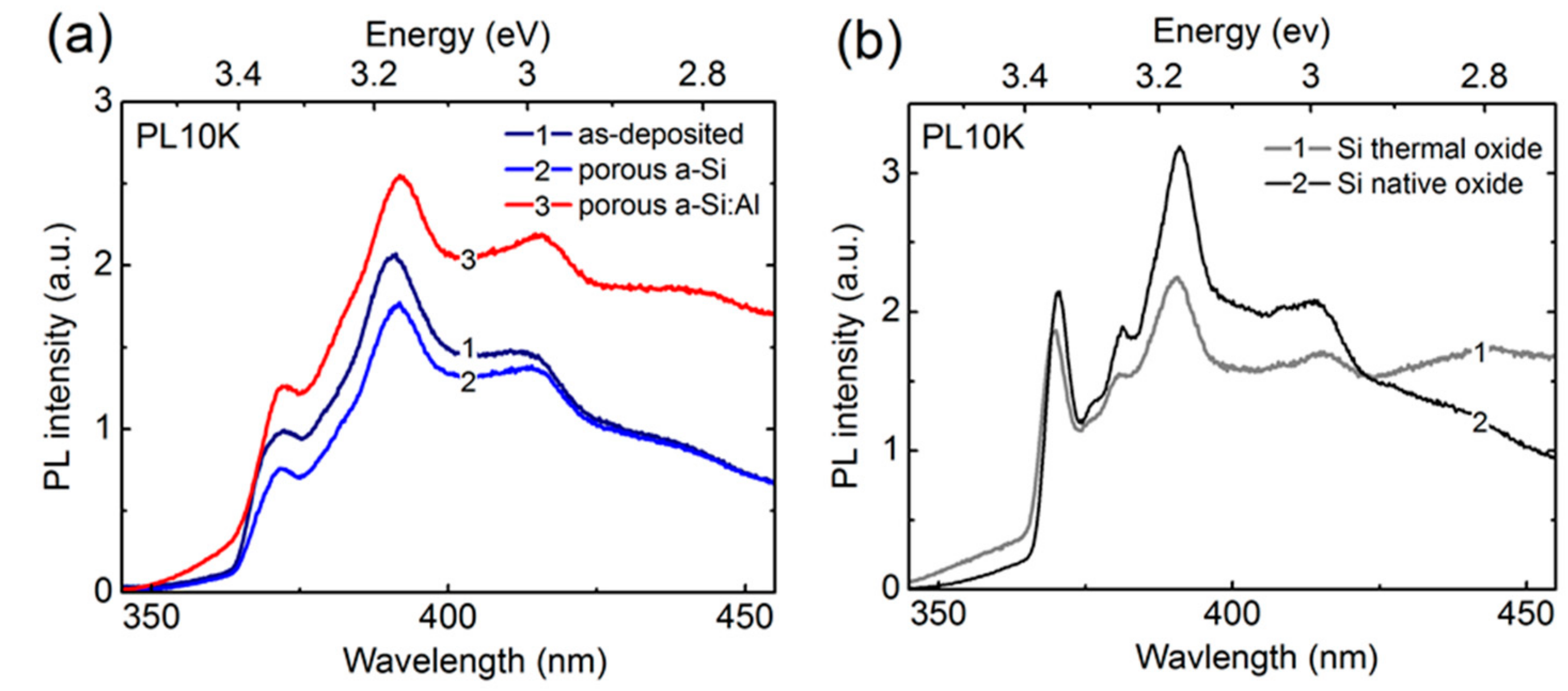
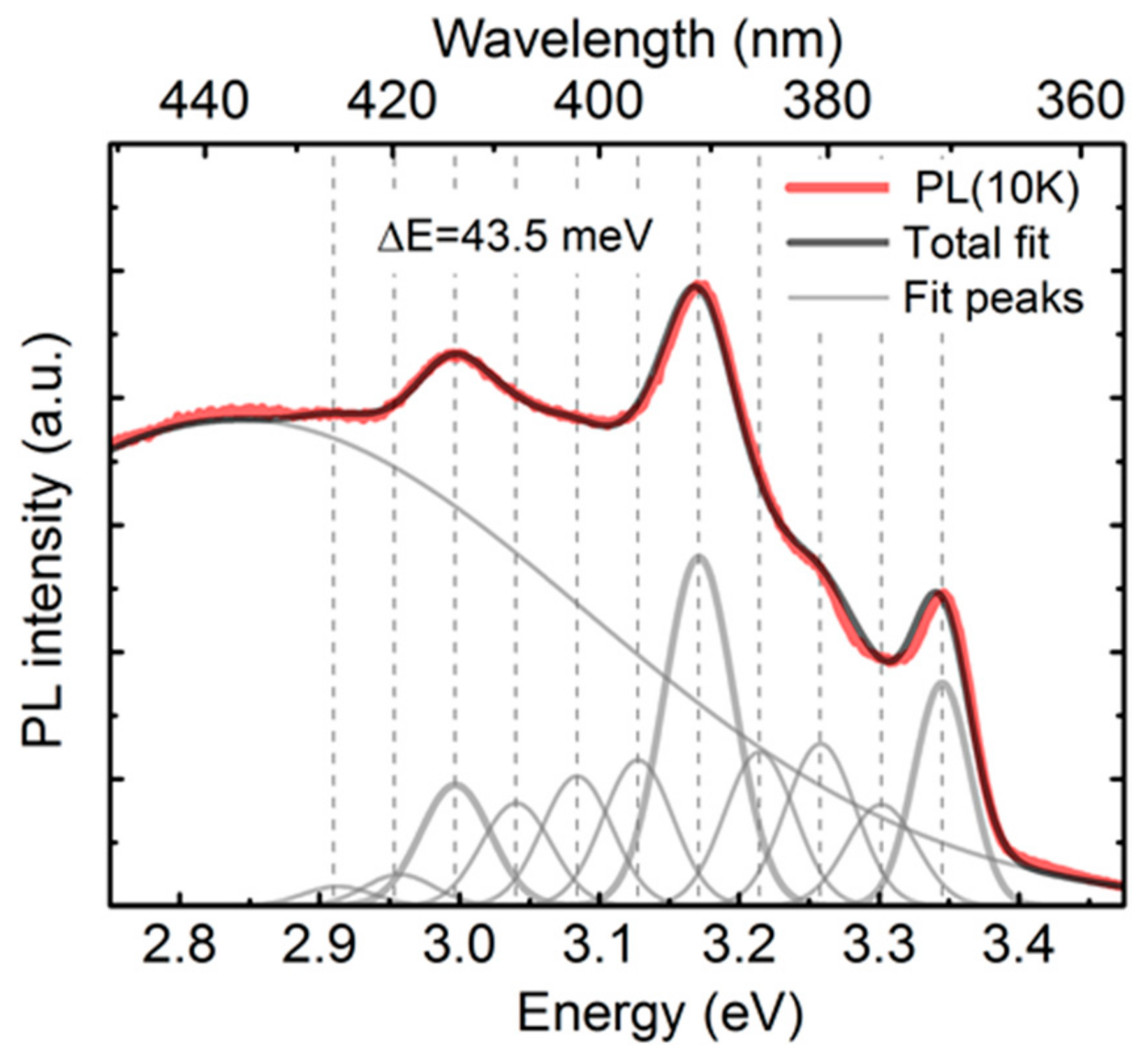
© 2019 by the authors. Licensee MDPI, Basel, Switzerland. This article is an open access article distributed under the terms and conditions of the Creative Commons Attribution (CC BY) license (http://creativecommons.org/licenses/by/4.0/).
Share and Cite
Kjeldstad, T.; Thøgersen, A.; Stange, M.; Jensen, I.T.; Monakhov, E.; Galeckas, A. Surface Effects and Optical Properties of Self-Assembled Nanostructured a-Si:Al. Nanomaterials 2019, 9, 1106. https://doi.org/10.3390/nano9081106
Kjeldstad T, Thøgersen A, Stange M, Jensen IT, Monakhov E, Galeckas A. Surface Effects and Optical Properties of Self-Assembled Nanostructured a-Si:Al. Nanomaterials. 2019; 9(8):1106. https://doi.org/10.3390/nano9081106
Chicago/Turabian StyleKjeldstad, Torunn, Annett Thøgersen, Marit Stange, Ingvild Thue Jensen, Eduard Monakhov, and Augustinas Galeckas. 2019. "Surface Effects and Optical Properties of Self-Assembled Nanostructured a-Si:Al" Nanomaterials 9, no. 8: 1106. https://doi.org/10.3390/nano9081106
APA StyleKjeldstad, T., Thøgersen, A., Stange, M., Jensen, I. T., Monakhov, E., & Galeckas, A. (2019). Surface Effects and Optical Properties of Self-Assembled Nanostructured a-Si:Al. Nanomaterials, 9(8), 1106. https://doi.org/10.3390/nano9081106




